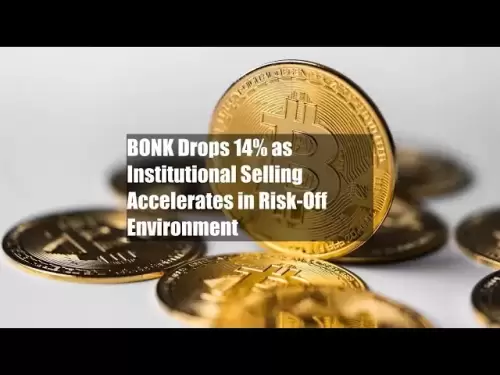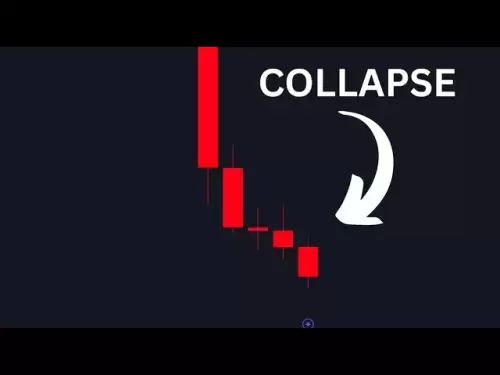 |
|
 |
|
 |
|
 |
|
 |
|
 |
|
 |
|
 |
|
 |
|
 |
|
 |
|
 |
|
 |
|
 |
|
 |
|
Cryptocurrency News Articles
What do Binance’s recent outages, token volatility, and legal disputes tell us about the broader challenges it faces across different regions?
Apr 17, 2025 at 04:29 am
Binance is back in the headlines

Binance, the world’s largest cryptocurrency exchange by trading volume, has hit a turbulent stretch this April with two major incidents occurring just days apart.
The first incident, which occurred on April 15, saw Amazon Web Services (AWS) suffer an outage in the AP-NORTHEAST-1 region, impacting Binance’s systems and leading to the temporary suspension of crypto withdrawals.
This outage affected several leading exchanges and crypto platforms, which faced technical disruptions as AWS services went down.
Just two days earlier, on April 13, the Mantra (OM) token, a fast-emerging crypto asset tied to real-world asset tokenization, experienced a sudden and severe crash.
Within an hour, its price plummeted from $6.32 to $0.42, erasing over $5.5 billion in market value.
Binance, one of the main exchanges where OM is heavily traded, was quickly drawn into the spotlight with allegations ranging from forced liquidations to questions about unusual token activity before the crash.
In response, Binance denied any direct involvement or misconduct.
These incidents come as Binance continues to face mounting legal and regulatory pressures. The exchange is currently battling an $81.5 billion lawsuit in Nigeria and remains under investigation by the U.S. Securities and Exchange Commission.
What really happened during the AWS outage
The trouble began early on April 15 at 1:15 a.m. PDT (8:15 a.m. UTC) when AWS experienced a power-related failure in its AP-NORTHEAST-1 region.
Both the primary and backup power supplies to a set of cloud servers, specifically EC2 instances, failed simultaneously, thereby triggering a ripple effect across 12 critical AWS services.
Binance, along with several other centralized exchanges such as KuCoin, MEXC, and Coinstore, was severely affected. Platforms and tools that rely on real-time data, including DeBank and Rabby Wallet, also began to experience disruptions.
By 8:05 a.m. UTC, Binance posted a notice on X confirming it was facing network issues due to the AWS outage. The exchange noted that while some trades were processed successfully, others were not. Users were advised to retry any failed orders.
Just two days earlier, on April 13, the Mantra (OM) token, a fast-emerging crypto asset tied to real-world asset tokenization, experienced a sudden and severe crash.
Within an hour, its price plummeted from $6.32 to $0.42, erasing over $5.5 billion in market value.
Binance, one of the main exchanges where OM is heavily traded, was quickly drawn into the spotlight with allegations ranging from forced liquidations to questions about unusual token activity before the crash.
In response, Binance denied any direct involvement or misconduct.
These incidents come as Binance continues to face mounting legal and regulatory pressures. The exchange is currently battling an $81.5 billion lawsuit in Nigeria and remains under investigation by the U.S. Securities and Exchange Commission.
What really happened during the AWS outage
The trouble began early on April 15 at 1:15 a.m. PDT (8:15 a.m. UTC) when AWS experienced a power-related failure in its AP-NORTHEAST-1 region.
Both the primary and backup power supplies to a set of cloud servers, specifically EC2 instances, failed simultaneously, thereby triggering a ripple effect across 12 critical AWS services.
Binance, along with several other centralized exchanges such as KuCoin, MEXC, and Coinstore, was severely affected. Platforms and tools that rely on real-time data, including DeBank and Rabby Wallet, also began to experience disruptions.
By 8:05 a.m. UTC, Binance posted a notice on X confirming it was facing network issues due to the AWS outage. The exchange noted that while some trades were processed successfully, others were not. Users were advised to retry any failed orders.
At 8:07 a.m. UTC, Binance temporarily suspended all withdrawals. The exchange stated that this move was “to keep safe,” describing it as a precautionary step while backend systems remained unstable.
At 8:16 a.m. UTC, Binance announced that services were starting to recover. Withdrawals were reopened, though the exchange warned users that delays might persist.
Although AWS officially resolved the outage by 8:51 a.m. UTC, Binance’s systems did not bounce back immediately. As late as 9:30 a.m. UTC, users continued to report slow performance, failed trades, and missing confirmations.
During the outage, users encountered a range of glitches. Binance’s app displayed red error warnings and greyed-out fields, particularly for withdrawals involving major blockchains such as Ethereum (ETH), Solana (SOL), Polygon
Disclaimer:info@kdj.com
The information provided is not trading advice. kdj.com does not assume any responsibility for any investments made based on the information provided in this article. Cryptocurrencies are highly volatile and it is highly recommended that you invest with caution after thorough research!
If you believe that the content used on this website infringes your copyright, please contact us immediately (info@kdj.com) and we will delete it promptly.


























































